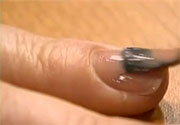- How Daily Prunes Can Influence Cholesterol and Inflammation
- When to Take B12 for Better Absorption and Energy
- Epsom Salts: Health Benefits and Uses
- See What Saffron Can Do for Sleep and Heart Health
- 6 Common Mistakes to Avoid Before Your Physical
- Can Sweating Really Help You Beat a Cold?
- Strengthening Your Relationship: Practical Strategies
- Skip Storing This Everyday Product in the Fridge Door
- Green Tea + B3 Pairing May Boost Brain Health
- Navigating Your Midlife Crisis: Embracing New Possibilities
Nail Salons’ Drying Lamps Carry Only Small Cancer Risk


A typical salon manicure involves drying freshly painted nails under a lamp that emits ultraviolet-A (UV-A) rays — a spectrum of light long linked to skin cancers.
But a new study suggests that the average visit to a nail salon carries little carcinogenic potential.
“Considering the low UV-A energy exposure in an average manicure visit, multiple visits would be required to reach the threshold for potential DNA damage” that might spur cancer, wrote a team reporting their findings April 30 in JAMA Dermatology.
In the study, researchers led by Dr. Lyndsay Shipp of the department of dermatology at Georgia Regents University, in Augusta, say that prior studies into the use of UV-emitting nail polish drying lamps have not had sufficient rigor to come to any reliable conclusions.
In their study, Shipp’s team used high-tech meters to measure the UV-A light exposures upon hands held in various positions under 17 different types of drying lamps. The researchers conducted the study at 16 nail salons.
First of all, they said, there were “notable differences” in the amount of UV-A light emitted by the various devices, and the amount of exposure to the hands also varied depending on the positioning of the device.
Overall, a single nail polish drying session under one of the lamps would not expose a person to a potentially cancer-causing amount of UV-A light, Shipp’s team said, and “even with numerous exposures, the risk for carcinogenesis remains small.”
Still, they say they agree with the authors of prior studies that precautions should be taken, including the use of sunscreens on the hands or UV-A protective gloves to limit both cancer risk and premature aging of the skin.
Dr. Chris Adigun is assistant professor of dermatology at NYU Langone Medical Center in New York City. He agreed that clients should wear some form of UV protection when using salon drying lamps.
He also believes that the study has “exposed an issue that needs to be addressed — that there is little to no regulation on the manufacturing of these nail lamps.”
“As a result,” Adigun said, “the bulbs, wattage and irradiance of these lamps varies dramatically from one manufacturer to the next, and individuals utilizing these lamps in salons have no way of knowing just how much UV exposure their skin is receiving upon each manicure.”
Even though the study found the overall risk of skin cancer from UV lamps to be low, “there are reports of nonmelanoma skin cancers on the hands after UV nail lamp exposure,” he added. “What this article addresses is the lack of regulation of these lamps, leading to potentially varied malignancy risk from lamp to lamp and salon to salon.”
More information
There’s more on preventing skin cancer at the U.S. Centers for Disease Control and Prevention.
Source: HealthDay
Copyright © 2026 HealthDay. All rights reserved.










